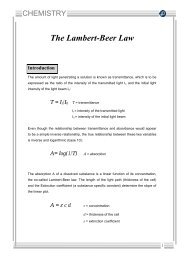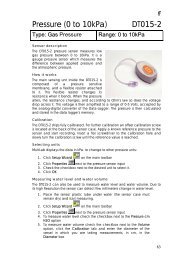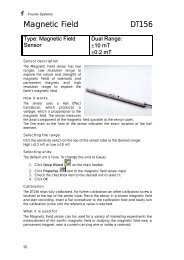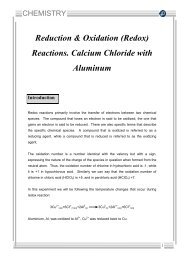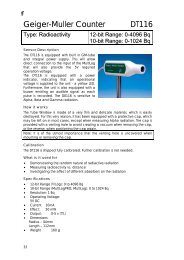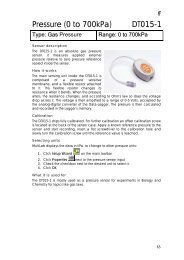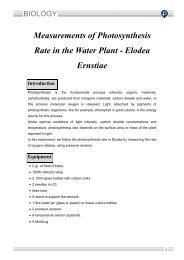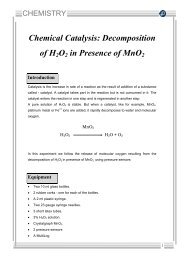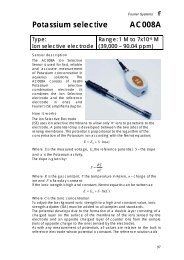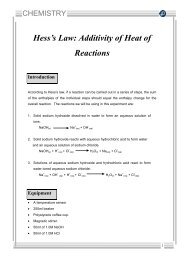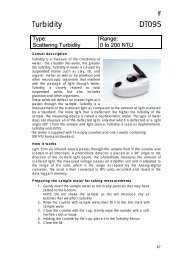Endothermic Reactions - Mixing Crystals of Barium Hydroxide and ...
Endothermic Reactions - Mixing Crystals of Barium Hydroxide and ...
Endothermic Reactions - Mixing Crystals of Barium Hydroxide and ...
Create successful ePaper yourself
Turn your PDF publications into a flip-book with our unique Google optimized e-Paper software.
CHEMISTRY<br />
<strong>Endothermic</strong> <strong>Reactions</strong> - <strong>Mixing</strong><br />
<strong>Crystals</strong> <strong>of</strong> <strong>Barium</strong> <strong>Hydroxide</strong> <strong>and</strong><br />
Ammonium Isothiocyanate<br />
Introduction<br />
When the two crystalline substances - Ba(OH) 2 ×8HO <strong>and</strong> NH 4 SCN are thoroughly<br />
mixed in a flask, a heat absorbing reaction is developed:<br />
Ba(OH)2 × 8H2O + 2NH4SCN<br />
Ba(SCN)2 + 2NH3 + 10H2O<br />
The gaseous substance - Ammonia (NH 3 ) , formed in this reaction, can be easily<br />
detected due to its pungent smell.<br />
If the flask, which feels very cold to the touch, is set on a board covered with a thin<br />
layer <strong>of</strong> water, the flask <strong>and</strong> the board freeze solidly together.<br />
In this experiment we follow temperature changes occurring during the mixing <strong>of</strong><br />
crystalline barium hydroxide octahydrate <strong>and</strong> ammonium Isothiocyanate. We<br />
experiment the freezing together <strong>of</strong> the reaction flask <strong>and</strong> the board.<br />
Equipment<br />
• A temperature sensor<br />
• 2 grams <strong>of</strong> Ba(OH) 2 ×8H 2 O<br />
• 4 grams <strong>of</strong> NH 4 SCN.<br />
• A wooden or a plastic board, approximately 5cm x 5cm.<br />
• A 10ml glass flask.<br />
1
CHEMISTRY<br />
• A 10 cm glass rod.<br />
• A MultiLog<br />
Equipment Setup Procedure<br />
1. Connect the MultiLog to the serial port <strong>of</strong> the computer.<br />
2. Connect the temperature sensor to the I/O 1 port <strong>of</strong> the MultiLog<br />
3. Assemble the equipment as illustrated in figure 1Abelow.<br />
4. Turn the MultiLog on. Set the MultiLog up according to the setup specified below.<br />
You can set up the MultiLog in two ways: Use the keypad <strong>of</strong> the MultiLog or select<br />
the Control Panel from the Logger menu.<br />
MultiLog Set Up<br />
• Input 1: Temperature<br />
• Rate: 1/sec.<br />
• Samples: 200.<br />
Figure 1A<br />
2
CHEMISTRY<br />
Experimental Procedure<br />
1. Pour some water on the board till it is partly covered with a thin layer.<br />
2. Weigh 2 grams <strong>of</strong> Ba(OH)2×8H2O in a 10 ml glass flask.<br />
3. Insert the temperature sensor into the barium hydroxide crystals in the flask.<br />
4. Weigh 4 grams <strong>of</strong> ammonium Isothiocyanate.<br />
5. Start the MultiLog by pressing the Run/Stop key in the MultiLog’s keypad. You<br />
can also start the MultiLog using the DB-Lab s<strong>of</strong>tware: Press the Run button from<br />
the Control Panel, or the (Run) button from the left toolbar.<br />
Wait till readings from the temperature sensor are stable.<br />
6. Add the weighed NH4SCN to the flask containing Ba(OH)2×8H2O.<br />
7. Put the flask on the board covered with the thin layer <strong>of</strong> water.<br />
8. Mix thoroughly the substances in the flask with the glass rod.<br />
9. Follow changes in temperature in the flask, registered on the monitor, till no<br />
further changes in temperature are observed.<br />
10.When the temperature is stabilized, stop the logging.<br />
11.Try to remove the flask from the board, as demonstrated in figure 1B.<br />
figure 1B<br />
Data Analysis<br />
1. Calculate the change in temperature obtained in the process. Calculate the time<br />
needed to reach the final temperature value: Use the grid to find the appropriate<br />
3
CHEMISTRY<br />
values: choose View\Display from the menu. Mark the option grid in the Option<br />
Display Window.<br />
2. Calculate the heat <strong>of</strong> reaction: C- water capacity; ∆t - temperature change.<br />
Water specific heat capacity at 25°C is 4.18 (J/g×°C).<br />
3. Summarize the results obtained with the board.<br />
An example <strong>of</strong> the graph obtained in this experiment, is shown in the next page:<br />
Questions<br />
1. What changes in the temperature in the flask did you observe? Explain your<br />
results.<br />
2. What kind <strong>of</strong> chemical reaction occurred in the flask?<br />
3. Explain the results you obtained with the board.<br />
Further Suggestions<br />
1. Change the relative amounts <strong>of</strong> - Ba(OH) 2 ×8H 2 O <strong>and</strong> NH 4 SCN <strong>and</strong> follow the<br />
temperature change in each case.<br />
2. Perform an additional endothermic reaction: Dissolution <strong>of</strong> KNO 3 in water (25<br />
grams in 50ml water).<br />
3. Follow the rate <strong>of</strong> ammonium release in the reaction, using a pressure sensor. In<br />
this way the reaction rate can be measured.<br />
4
CHEMISTRY<br />
Advantages <strong>of</strong> Using the MultiLog in<br />
Studying <strong>Endothermic</strong> <strong>Reactions</strong><br />
1. Real time measurements <strong>of</strong> changes in temperature.<br />
2. A very simple experimental system that enable the student to perform various<br />
experiments, leading to improved comprehension <strong>of</strong> the process <strong>and</strong> the meaning<br />
<strong>of</strong> heat <strong>of</strong> reaction.<br />
5



